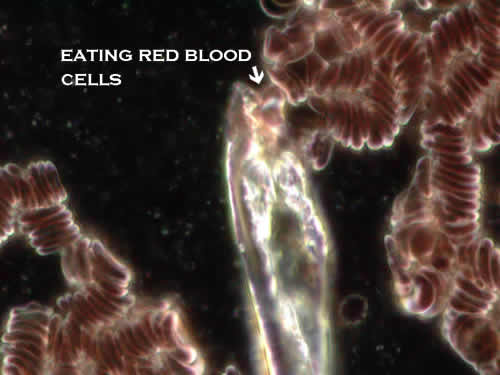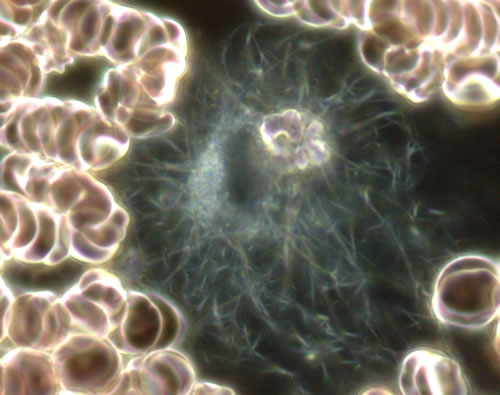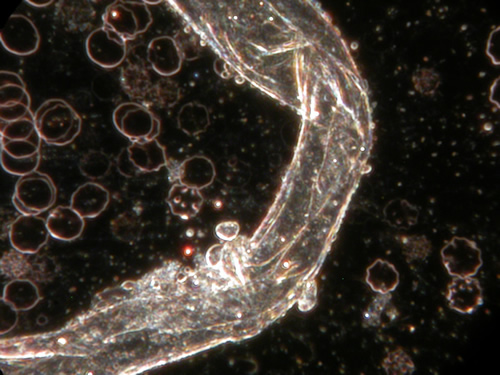How Parasites Die |
m | ||||||
Posted to Subscribers on 6 August 2009 |
|||||||
|
|
Gross, I know. However, this subject is important and for all intents and purposes, you are on your own when it comes to diagnosing the presence or absence of parasites. For the sake of simplicity, let's say there are two basic types of parasites, those that live in the bloodstream and those that are intestinal. The division doesn't make sense because like other creatures who must eat, they move about, going to where there is the most benefit for the least effort. In short, your body has many restaurants of interest to these meandering vagrants. You could also divide parasites into microscopic and visible to the naked eye. It makes just about the same amount of sense. Some of the parasites we see in the microscope look so big that you think you'd be able to see them without magnification but when we remove them from the scope, we can't actually see them even though they might easily be 700 microns in length. That's about one hundred times the diameter of a normal red blood cell. In previous posts, I have mentioned that these parasites come in many descriptions and they have somewhat different hunting patterns. If you said they are miniature snakes and have as much variation in design as snakes, it would be a fair comparison. The ones seen in the blood forage on red blood cells. It would not surprise me if they ate other blood components, but I have only seen them eating erythrocytes.
There are voracious eaters as well as some very picky parasites who eat only crenated red blood cells. These cells are probably not long for this life anyway. It is estimated that RBCs normally live 120 days, but I suspect many suffer from infant mortality and other life hazards, such as predators. For the record, use of cell phones promotes very rapid crenation because the frequencies of the cell phones cause tiny perforations in the lipid membrane of the cells. Some might recover from this trauma if given the right support, but many will die. With the transitioning of Ted Kennedy last night, we ought all to be reminded to take the measures necessary not to fall victim to harmful effects of cell phone radiation. I don't suppose his death will be blamed on cell phone use or parasites, but this is why you are on your own. Many people are using zappers or some spin off of Rife technology to murder parasites. I have had a few occasions to view the aftermath in the scope. What I have seen is that the frequencies, as one would expect, only effect certain parasites so the others survive. If you had the right frequencies and were aware of all the types of parasites present, you might be able to resolve the problem. Otherwise, the bottom line is that the population of parasites will shift but there will be offspring of the war heroes. With the zapper, the small blood parasites shrivel up and float around as debris. I did not see any indications that the debris was being managed, something I will explain in more detail in a moment. If I were in a position to study 50 or a 100 patients using the zapper, my impressions might change, but from the few slides I did study, the debris was not addressed. With the bigger machines, I saw massive electroperforation of the soft tissue but the parasites retained their forms, almost as if frozen in time. In darkfield, it was not possible to see what was holding the tissue together, presumably muscle tissue since the outer membranes were trashed. They parasites seemed more or less inert, corpses but perhaps sterilized in some manner. However, they were still in the plasma and not eliminated. Again, I am only tossing this out because sooner or later, someone has to research this properly, but given the lay of the land here, it won't happen in the U.S. When you take herbs, the parasites either die from toxicity or they are sedated enough that the blood cells will attack them. There are many possible scenarios here so try to bear with me a bit. If the parasites die of poisoning, they will either be eaten by bacteria or they will break down through a very nasty looking fermentation process. Bacteria If they are eaten by bacteria, the bacteria gnaw away at the fleshy parts of the parasites and this generally takes them a few days. In short, the patient has what seems like a mild bacterial infection and might be achy for 1-5 days, usually only 1-2 days. When the bacteria have eaten as much as they can, the white blood cells eat the bacteria and then spray something on the tougher parts of the remaining corpses. At this point, the parasite graveyard looks like a field of little sticks, fibrin. This interferes with the movement of the red blood cells and the white blood cells solve the problem by dissolving the webs with the mist that they secrete. It takes them a day or two to clean up the mess.
In short, the patient is parasite-free in a week, but the parasites will have mated and procreated so when the eggs hatch, there will be lots of little orphan parasites in the blood. Being young, they are small and relatively easily vanquished, but it usually takes months to get rid of all the generations of parasites. Fermentation If for any reason the white blood cells are incompetent, the dead parasites are not eaten by bacteria. So, I believe that what is absolutely not understood at all by modern science is that the white blood cells are actually the transporters of friendly bacteria and they sometimes eat the dangerous bacteria as well. They are quite discerning and normally not inclined to commit suicide. If someone takes antibiotics for the bacterial infection, the process of debris clean up is disrupted and the decomposition will take longer and entail massive fermentation. If you look at these parasites, it's pretty disgusting . . . in a fascinating sort of way. When this happens, you see the skin of the parasite looking slimmy and soft and then bubbles start coming out. Eventually, the entire area around the dead parasite is full of bubbles and the tissue looks like any other decomposing tissue.
In short, there is a choice: bacteria or bubbles. I would prefer the bacteria over the bubbles. It's a very straightforward and clean process. You might say that the body's mortuaries are efficiently operated and hygienic whereas with the fermentation, there is a maverick brewery run by part-time fugitives who haven't read the operating manuals. Antibiotics Okay, my imagination probably seems too vivid for some of you, but if I tried to explain something to people who have never never seen live blood before, where would I start? It is very distressing to me that antibiotics are administered so recklessly because not only are the intestines impacted by the loss of friendly bacteria but the white blood cells themselves are rendered incapacitated. They are therefore subject to early retirement because of incurable complications affecting their ability to perform their jobs. This is sad because they actually seem proud of their work and they are endlessly fascinating to watch. Worse, the recovery time for the body is unpredictable because many antibiotics are made with viable fungi. I know this because I have seen the fungal overgrowth and studied what is in the capsules. Once again, give me a choice between a mild bacterial infection and a fungal infection and I will choose the bacteria any day. ID Cards for Aliens Since parasites are stowaways, you might say their papers are not in order. They are often therefore misidentified. You know, it would be something like saying a Chinese national is Korean or Mexican. Without documents, you might never be sure. Pathologists and microbiologists and parastologists have a murky vocabulary in which sometimes bacterial forms are called parasites or vice versa. I once watched a bacterium fight a spirochete for hours. It was impossible to predict outcome because from one moment to the next, it was not clear which would win. They might take days duking it out. In short, there are other little creatures in the "sterile" stuff called blood. There are some long wigglies that seem to eat micronutrients and perhaps even platelets. They also sometimes act like woodpeckers and get their heads inside red blood cells. If they succeed, they grow very fast, doubling and tripling in length in a matter of a few minutes. They don't usually succeed if the membrane is tough. In this case, they get tired and when they are tired enough, a group of red blood cells will gang up on them and harass them, but they don't seem to have a way of killing these creatures. These creatures are very easily vanquished with herbs but I would wager 99% of people who have them are clueless about their presence inside their turf. Patients don't get much help from doctors because officially the blood is sterile so the stowaways rarely get asked for their papers. Since this is very hard to visualize, when I post this email online, I will — as I almost always do — add images. Though not every email is posted online, most are. The index can be found at: http://www.ingridnaiman.com/subscription_posts/email_index.html Hundreds and hundreds of posts have been sent over the last many years. Only the more recent ones have been put online, but in the near future, I will try to upload more. Normally the uploading occurs within hours of posting. Also, the size of the subscription list has been more or less the same for years. If your friends want to subscribe, please tell them it's easy. Just use the link on any of my 35 web sites. Offshore Clinic A few of you wrote asking if I was facetious or serious about a clinic. I am 100% serious. I posted a vision years ago: http://www.cancerchecklist.com/visions/treatment_sanctuary.html There are details that could change, including that many conditions would be addressed, but at the age of 67, I have had occasion to study the strengths and weaknesses of countless clinics. If I were to state these, I think you would be interested and perhaps also find me too critical, but the ideal clinic has yet to be created. There are countless models to study, but the one that has not been formed is a patient-owned clinic in which financial decisions are made by the patients and medical decisions are made by the staff in collaboration with each other and well-informed patients. People doubt this can be done, but the Vienna Philharmonic is operated by the musicians who hire conductors after considering the options and availability. We can become trapped in the mania for more mainstream medicine and then end up with a bureaucratic nightmare or we can take matters into our own hands and make sure provisions have been made for future needs. If you like, I will write some assessments of what I consider to be the pros and cons of the various models in existence, but I won't do this today. Many blessings, Ingrid
Copyright by Ingrid Naiman 2009
|
||||||
Home || Contact Us |
|||||||
No content on any of the pages of this web site may be reproduced without written permission of Ingrid Naiman and Seventh Ray Press, publisher of this site. |
|||||||
|
|||||||



